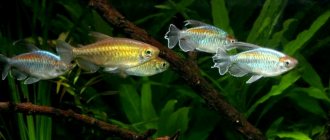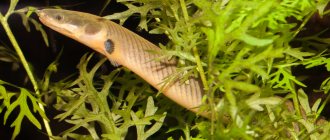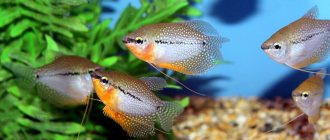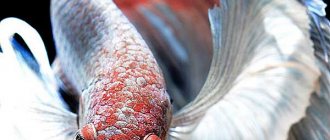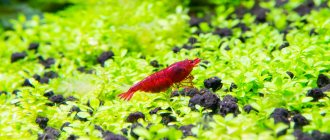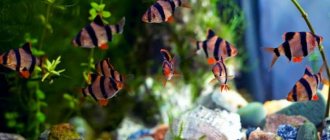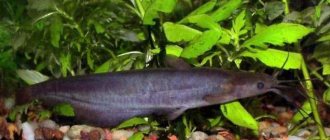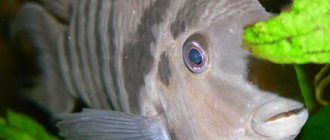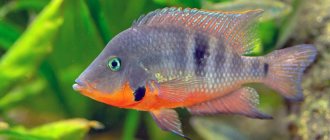Nowadays, parrot fish are one of the most popular inhabitants of aquariums. This representative of the cichlid family is also called a three-hybrid or red parrot. The reason is that the fish is a triple cross hybrid. Bright, with a funny face, similar to cartoon characters, it was bred in the 90s of the last century by breeders in Taiwan. Since then, the method of breeding parrots has been kept secret, and the production of the hybrid increases every year.
Not just a fish, but a beauty and smart girl
Red Parrot Cichlid (as the red parrot is called in the world) is an unpretentious and intelligent fish. She recognizes her owner and even allows herself to be petted. But, unfortunately, like all hybrids, it is not capable of producing offspring. The parrot fish got its name because of its bizarre head, which in structure resembles the beak of the bird of the same name. Common representatives of the species are red-orange or yellow, sometimes albinos.
In nature, the parrot fish, from which ornamental fish originated, lives in the tropical waters of the Pacific, Atlantic, and Indian oceans. Prefers to live within coral reefs, feeding on polyps. It also eats mollusks and other small marine crustaceans.
Some species of parrots have one interesting feature: before going to bed, the fish wrap themselves in a cocoon of mucus, which they secrete from their mouths. The protective shell hides parrots from microscopic parasites and large predators (they do not smell it).
Breeders paid attention to the parrot fish because of its unusual shape and bright color. Artificially bred species would not be able to live in natural conditions. For the sake of commercial interests, they were deprived of many useful properties necessary for life in the wild. However, parrot hybrids live successfully in an aquarium and do not require special care.
Parrot fish in nature
Before getting into the aquarium, this amazing fish lived in the reservoirs of the African continent. Its favorite habitats are ponds overgrown with dense vegetation. In freedom, parrots grow up to 10 cm. In captivity, their size is slightly smaller, about 7 cm.
Aquarium blue parrot fish
The unusual body shape of parrot fish and their fabulous color have long attracted people's attention. Nature has endowed them with a variety of colors. Depending on their location and habitat, fish are divided into species. The most common fish are white Parrots. What is this – a natural color of the fish or an albino fish?
The thing is that this type of fish has one interesting property - they lose their colors during stressful situations. Out of fear, and meeting a person in nature is a stressful situation for them, the fish completely lose all their colors.
The red Parrot fish found in the aquarium is a species that does not exist and has never existed in the wild. This fish is the fruit of long and hard work of breeders, who still keep it a big secret who they crossed and with whom to get such beauty.
Red parrot fish
A photo of the Parrot fish confirms its uniqueness and unusualness.
Its profile, so reminiscent of the bird for which it is named, cannot be confused with anyone else.
Description of type, shape and colors
The Scaraceae family, which includes the parrotfish, belongs to the ray-finned fish and has 10 genera and 99 species. The most common wild ones:
- red parrots;
- scars;
- green cone-faced ones.
We recommend reading
: Why do guppies die in an aquarium?
The red parrot has a peculiar beak with sharp teeth, which it uses to gnaw coral in search of food. The fish is peaceful. Popular with aquarists.
Scars are small parrot fish. They take root well in captivity.
The green coneface is the largest representative of the family. Under natural conditions it grows up to a meter long and weighs up to 40 kg. Smaller fish live in captivity, but in the event of a quarrel with other inhabitants of the aquarium, the Bone-fronted Parrot can act with its forehead like a battering ram and cause serious harm to rivals.
According to the shape of the body, head and fins, ornamental fish are distinguished:
- a unicorn with a growth on its forehead;
- King Kong - the fish has a fatty roll on its head;
- red fish fortune - a large growth on the head, fins are elongated;
- love heart - no caudal fin;
- red ingot - the body of the fish resembles a disk.
Description
Parrot aquarium fish are a phenotype developed by crossing American cichlids. The process itself, the number and names of species are kept strictly secret by breeders, because breeding aquarium parrot fish is a profitable business. True, some aquarists claim that they have unraveled the secret of crossing. However, all specimens of parrot fish that are commercially available are brought from Southeast Asia.
As a result of crossing, the cichlids received an unusual physique: a curved spine and a tiny mouth that opens incorrectly. Sometimes these body features are poorly formed and lead to the death of some individuals at an early age. The description of the appearance of the parrot cichlid is reminiscent of a cartoon movie character - a cartoon fish. Due to their friendly expression, curved head like a parrot, and rich coloration, cichlids have gained enormous popularity in the field of aquarium keeping. Parrots also have developed intelligence and a friendly character, thanks to which they easily find a common language with other fish.
The parrots did not inherit the shortcomings of their parents - aggression and gloominess.
Red and blue fish
Aquarium parrotfish reach 10-15 cm in length and are most often found in red, orange, purple or yellow. White albinos are sometimes found. But the fantasies of Asian innovators are unpredictable, and they came up with the idea of artificially coloring poor fish in all the colors of the rainbow. This is how blue, purple, blue parrots appeared on the market.
The painting process is painful. First, the fish are placed in an alkaline solution to remove protective mucus from the surface of the skin. They are then dipped in dye, or tattooed on the unfortunate creatures' sides. Finally, they are placed in a special solution that causes the parrotfish to produce protective mucus again. Many fish cannot withstand the procedure and die from pain and stress.
There are oceanic parrotfish of blue or light blue color, but they are rare and are not kept in aquariums.
Other natural varieties of parrot are panda, marbled and diamond. These fish are spotted.
How did parrot fish appear?
Parrot Cichlids are not found in nature. Taiwanese breeders managed to obtain them in the 1990s by crossing rainbow and citron cichlases. Most likely, the crossing was triple. It is believed that the third parent could be the spotted cichlazoma Fenestratum.
The exact hybridization scheme is hidden by manufacturers: a trade secret.
Taiwanese breeders strive to get the maximum benefit from the sale of their creation, especially since it is extremely popular. The fact that parrotfish lay non-viable eggs plays into their hands.
The reproduction of the hybrid is carried out only in Taiwan, from where the fry are supplied to stores all over the world. The only way to get this hybrid into your aquarium is to buy fry or adults at a pet store. Home breeding will not be successful.
Life expectancy and illness
The normal age of a parrotfish is about 10 years. Painted and tattooed individuals have a shorter lifespan due to reduced immunity. Fish can also die from disease.
We recommend reading
About Labidochromis yellow and other cichlids
If your pet's body is covered with dark spots, the reason is most likely due to the high content of nitrates in the aquarium water. It is necessary to change the water at least half and clean the soil.
Small white spots, similar to semolina, are a sign of ichthyophthyriasis in parrotfish. The water must be changed by a third, the filter and soil must be cleaned. Then add the remedy for this disease Sera costapur (Sulfur Costapur) at the rate of 10 drops per 20 liters of water. The medicine decomposes in light, so the procedure must be carried out in the dark. Then, for a week, change a third of the water every day, adding the appropriate amount of the drug.
If the parrot fish has sank to the bottom, it needs to be removed from the rest and treatment must begin.
Compatibility with other aquarium inhabitants
These are quite peaceful fish that get along well with other similar-sized inhabitants of the underwater world. Parrots perceive all small fish as food. Aggressive fish can drive this species, so you should avoid proximity to the following representatives of the underwater world:
- cichlasma meeca;
- Cichlasma Nicaraguan;
- Acara bluish-spotted;
- angelfish
A species aquarium would be the best solution. If you wish, you can select neighbors. Parrot fish are housed with non-aggressive:
- cichlids;
- black-striped cichlasomas;
- lemon labidochromis (“Yellow”);
- barbs;
- large irises;
- various catfish.
Also suitable are tetras, mettinis, congo, tetragonopterus and cyprinids.
Guppies, neons are not the best option. They will become easy prey for parrots.
Who do pets get along with and how to keep them
The parrot is not a conflict fish. Gets along well with other animals of approximately the same size. But small fish can simply be swallowed, mistaking them for food. In an aquarium with a red parrot you can breed large fish: catfish, labeo, characins, barbs, apteronotus and others.
Parrot fish do not require special care, but adults grow quite large, therefore an aquarium for them requires a volume of 180-200 liters per pair. It is better to cover it on top with a net or a special lid so that playful pets do not accidentally jump out and die.
It is better if there are 5-6 pets; if there are fewer of them, one pair of parrots will consider themselves dominant and will begin to “build” other inhabitants of the aquarium.
Parrotfish are shy. In the new aquarium they run wild and hide. This continues for 2-3 months, so do not rush to be disappointed if the purchased pets do not swim in plain sight.
Features of behavior and neighborhood
An individual feature of this variety of cichlids is that they are distinguished by a relatively peaceful disposition, unlike many of their other “brothers”. Therefore, they can calmly coexist peacefully in the same aquarium with other inhabitants. The main thing is to select individuals of approximately the same size. They can swallow fish that are too small, and this is a common occurrence for all these representatives of underwater fauna, not just parrots.
Astronotuses and parrots get along well in a common aquarium.
Among the neighbors, for example, swordtails, mollies, labeos, other cichlids, and various catfish are suitable. It will be better if all the inhabitants are placed in the aquarium at the same time. This is explained by the fact that they can perceive new fish aggressively. This is especially noticeable when the spawning period begins. Therefore, it is important that there are many different caves and shelters in the container, and then the males will not fight among themselves for territory.
Suitable water parameters
In nature, a parrot lives in running water, so successfully keeping these fish is impossible without a pump that saturates the water with oxygen. In addition to algae, the aquarium should have caves made of stones, coconut or other shelters where the parrots will hide. Place at least 5 cm of small pebbles on the bottom - active fish like to dig holes.
A good filter doesn't hurt either. The lighting is preferably dim and diffused.
We recommend reading
Black-striped and other cichlazomas
Requirements for water quality and temperature are common for most aquarium inhabitants:
- temperature 22-26°C;
- acidity pH 6.5-7.5;
- hardness 5-7 dGH
- nitrate content is close to zero.
Change at least 30% of the water once a week.
Content
Parrot fish are an excellent option even for beginner aquarists. She is unpretentious and therefore it is not difficult to provide her with proper care. In addition, these animals are very interesting, because they are always active and simply curious in their behavior. The conditions of detention are as follows:
Aquarium volume . It is important that its length is at least 70 cm and its volume is 150+ liters. This is explained by the fact that this aquarium fish is very mobile and therefore needs to be provided with a place where it can swim freely;
Equipment . Good filtration is required, since these cichlids leave behind a lot of waste, and it is not possible to plant live plants with them, since they like to rummage in the soil and therefore, as a rule, nothing from the underwater flora takes root. The best option is an external filter with fillers that provide chemical, biological and mechanical cleaning. If an aquarist is limited in funds, then he can independently make a phyto-filter, which will also be quite effective. In addition to filtration, good aeration is required, since due to the lack of plants it is not easy to maintain the required oxygen level;
Purple parrot
Water parameters . The temperature should be high, since parrots naturally live in equatorial or tropical climates. The optimal indicator is 22-28 degrees. In this case, the water should be quite hard, within 6-15°;
Substitutions . They are necessary regularly so that the water always remains fresh. It is advisable to carry out this procedure weekly, about a third of the total volume of the aquarium;
Soil and decor . Small pebbles are best. You can choose various stones and driftwood from the decorations. The main thing is to create full-fledged shelters where fish like to sit, especially during the spawning period.
Diet planning, interesting facts
Both dry and live food are suitable for the red parrot. A distinctive feature of these fish is their small mouth, so they cannot eat too large pieces of food. There is a special food for these pets, Tetra Red Parrot. It takes into account the structural features of the fish's mouth and contains carotenoids necessary to maintain the bright colors of parrots. But this does not mean that the fish diet should consist only of it. Other additives are required.
Live foods for parrotfish include worms, shrimp, and small fish. Unpretentious parrots will also eat bread crumbs, bloodworms, and chopped vegetables.
Parrots are very smart. If you always feed them yourself, they will soon begin to recognize their owner and will swim up to the wall of the aquarium as soon as you appear. The fish also perk up noticeably as soon as you approach the place where you store the food.
Feeding
It is not particularly complicated. Parrots have a good appetite and are not picky. Both dry food from manufacturers and various frozen varieties are suitable. For example, it could be shrimp, bloodworms, tubifex, brine shrimp, etc. The main part of the diet is food of animal origin, but you can also add some plant components.
With age, individuals slightly lose the richness of their colors. You can maintain it yourself, using special dry food or adding shrimp to your diet.
Is reproduction possible?
New parrotfish can only be obtained through artificial crossing. Hybrids created in this way cannot have offspring. Red parrots are also unable to reproduce. But, if you raise the temperature in the aquarium to 27-28°C, their sexual instinct awakens. The fish dig holes and build a nest. The female can even lay eggs, but the male will still not be able to fertilize her, he is sterile.
You can distinguish a female parrotfish from a male by its anal tubercle. In a male parrot it is cone-shaped, in a female it looks like a pear. Typically male fish are larger.
Artificially bred parrotfish fry are born gray-black and retain this dull color until they are 5 months old. Only after this do they acquire the bright, unique coloring characteristic of adult fish.
We tried to collect all the useful information about the aquarium parrot fish. If you have any questions or have something to tell, write in the comments. Share the article with your friends and like it.
Breeding
It is impossible to distinguish males from females until 1.5 years of age. Males are larger, brighter, and their fins are pointed.
Unfortunately, most males of such hybrids are sterile and it is impossible to produce offspring. However, having reached maturity, they prepare for reproduction, having found a mate, the fish begin mating games. They dig a hole where the female lays her eggs, the parents guard the eggs. But it remains unfertilized and dies over time. If there are males of closely related fish in the aquarium, they are able to fertilize the eggs.
In this case, the fry are gray-black for up to 5 months. Then they turn bright orange. Parents feed their offspring by grinding pieces of food in their mouths and spitting out the suspension. You can also give young animals special liquid food.
Types of colors
Taiwanese breeders did not stop with the initially obtained variation and continued their experiments. As a result, Parrot Cichlid was born in a variety of colors.
- Pearl (Kilin Parrot) - multi-colored parrots with small white speckles over the entire surface of the body. Obtained from crossing with Horn cichlizoma.
- Marble (Marbled_Parrot) – black stripes and stains on an orange background.
- Panda (Panda Parrot) – large black spots on a white background.
- With dark gray stripes on a white background (Parrot Cichlid Cichlid).
- With black spots on a red background, fins and tail are black (Parrot Cichlid Black).
Artificial colors
Having exhausted the possibilities of selection, the creators of aqua birds found a way to artificially change the color of their body. The body of a parrot can be given almost any color: purple, green, blue. There are fish with tattoos. Drawings are applied to their scales: abstractions, ornaments, hieroglyphs, flowers, specks. To change the color, injections of special dyes are used. This harms the health of the fish and shortens its lifespan. Often, an abnormally bright pet lives no more than six months and dies due to weakened immunity.
Artificial coloring is not permanent. Over time, it will turn pale, the fish will become normal, orange. Green specimens become pale pink.
Natural enemies of parrot fish
Photo: Parrot fish in the sea
Parrotfish do not have electrical discharge, spines or poison. She uses only mucus to protect herself. Therefore, one of the ways of protection is mucus, which she uses not only at night, but also during the day in case of danger. And danger to it can come from people who catch this type of fish because of its valuable, nutritional qualities and beneficial properties.
When catching fish with nets, it immediately and in large quantities begins to release its lubricant, but, unfortunately, this method of protection, when caught by a person using special equipment, is ineffective. But this cocoon is not dangerous for humans; on the contrary, it has many beneficial properties and vitamins.
Enemies can also include blood-sucking parasites from the order of higher crustaceans - isopods. Sharks, eels and other nocturnal hunters search for parrotfish using their sense of smell. To expel strangers from its territory, the parrot fish gathers in a group. Using sudden movements and his strong teeth, he intimidates and drives them out of their homes in a flock.
